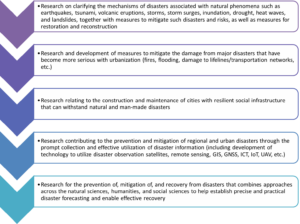DISASTER PREVENTION AND MITIGATION
Research on disaster prevention and mitigation towards social sustainability

As outlined in the United Nations Sustainable Development Goals (SDGs) under Goal 11: Make cities and human settlements inclusive, safe, resilient and sustainable, and Goal 13: Take urgent action to combat climate change and its impacts, disaster prevention and mitigation is a key issue facing humanity on a worldwide scale. In order to work toward the realization of safe, resilient, and sustainable cities and societies, it is necessary to conduct research that is founded soundly on local needs, and whose findings can be applied back to society. When addressing this need, in addition to utilizing Japan’s knowledge and experience it is important that research and development are conducted not only in Japan but as part of a worldwide framework, in a comprehensive and systematic manner. Plans such as the Sendai Framework for Disaster Risk Reduction 2015-2030 and the Sendai Cooperation Initiative for Disaster Risk Reduction, which were established at the Third UN World Conference on Disaster Risk Reduction in March 2015 call for collaboration between disaster prevention policy and scientific research as well as support for developing countries, including technology transfer. In addition, the Paris Agreement finalized at COP21 in December 2015 outlines international targets and contribution in the DRR field, and research toward disaster risk prevention and mitigation is widely recognized as a key task both in Japan and overseas.
Amidst these circumstances, in addition to addressing natural disasters such as earthquakes, tsunami, volcanic eruptions, storms, storm surges, inundation, drought, heat waves, and landslides, this research area also includes research on preventing and mitigating disasters that urbanization may exacerbate (including research on post-disaster recovery and reconstruction). Examples include large fires in densely populated urban areas, flood damage, traffic and transportation accidents, damage to social infrastructure, and large-scale accidents at industrial complexes. It is important to adopt an integrated approach spanning disaster occurrence, forecasting, countermeasures, and a road map to practical application while also seeking interdisciplinary collaboration with various fields beyond one’s field of expertise. This includes analysis and explication of disaster mechanisms, validation of existing disaster risk reduction measures, and verification of risk communication strategies. When studying post-disaster recovery and reconstruction it is particularly important that those vulnerable to damage, such as women, children, and persons with disabilities, are taken into consideration. In this regard, research topics which incorporate the perspective of SDG 5: Achieve gender equality and empower all women and girls are particularly welcome.
Examples of the list main research subjects:-

*Other subjects are also acceptable if they meet the requirements mentioned above.
